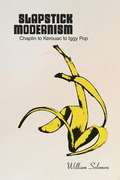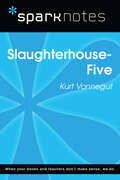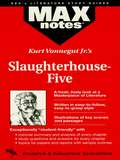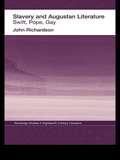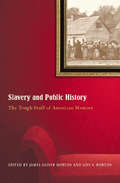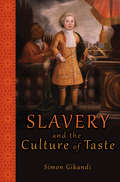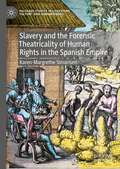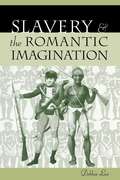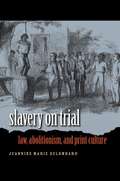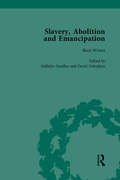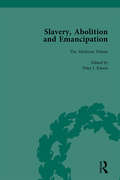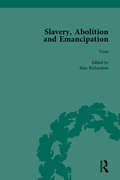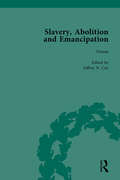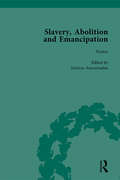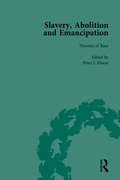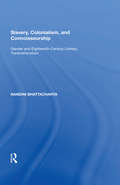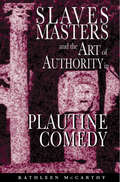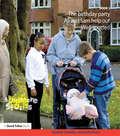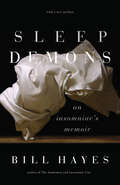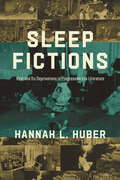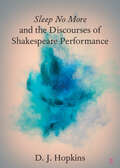- Table View
- List View
Slapstick Modernism: Chaplin to Kerouac to Iggy Pop
by William SolomonSlapstick comedy landed like a pie in the face of twentieth-century culture. Pratfalls and nyuk-nyuks percolated alongside literary modernism throughout the 1920s and 1930s before slapstick found explosive expression in postwar literature, experimental film, and popular music. William Solomon charts the origins and evolution of what he calls slapstick modernism --a merging of artistic experimentation with the socially disruptive lunacy made by the likes of Charlie Chaplin. Romping through texts, films, and theory, Solomon embarks on a harum-scarum intellectual odyssey from high modernism to the late modernism of the Beats and Burroughs before a head-on crash into the raw power of punk rock. Throughout, he shows the links between the experimental writers and silent screen performers of the early century, and explores the potent cultural undertaking that drew inspiration from anarchical comedy after World War Two.
Slaughterhouse 5 (SparkNotes Literature Guide Series)
by SparkNotesSlaughterhouse 5 (SparkNotes Literature Guide) by Kurt Vonnegut, Jr. Making the reading experience fun! Created by Harvard students for students everywhere, SparkNotes is a new breed of study guide: smarter, better, faster. Geared to what today's students need to know, SparkNotes provides: *Chapter-by-chapter analysis *Explanations of key themes, motifs, and symbols *A review quiz and essay topicsLively and accessible, these guides are perfect for late-night studying and writing papers
Slaughterhouse-Five (Maxnotes Literature Guides)
by Tonnvane WiswellREA's MAXnotes for Kurt Vonnegut Jr.'s Slaughterhouse-Five MAXnotes offer a fresh look at masterpieces of literature, presented in a lively and interesting fashion. Written by literary experts who currently teach the subject, MAXnotes will enhance your understanding and enjoyment of the work. MAXnotes are designed to stimulate independent thought about the literary work by raising various issues and thought-provoking ideas and questions. MAXnotes cover the essentials of what one should know about each work, including an overall summary, character lists, an explanation and discussion of the plot, the work's historical context, illustrations to convey the mood of the work, and a biography of the author. Each section of the work is individually summarized and analyzed, and has study questions and answers.
Slavery and Augustan Literature: Swift, Pope and Gay (Routledge Studies in Eighteenth-Century Literature)
by Dr J RichardsonSlavery and Augustan Literature investigates slavery in the work of Jonathan Swift, Alexander Pope and John Gay. These three writers were connected with a Tory ministry, which attempted to increase substantially the English share of the international slave trade. They all wrote in support of the treaty that was meant to effect that increase. The book begins with contemporary ideas about slavery, with the Tory ministry years and with texts written during those years. These texts tend to obscure the importance of the slave trade to Tory planning. In its second half, the book analyses the attitudes towards slavery in Pope's Horatian poems, An Essay on Man, Polly, A Modest Proposal and Gulliver's Travels. John Richardson shows how, despite differences, Swift, Pope and Gay adopt a mixed position of admiration for freedom alongside implicit support for slavery.
Slavery and Public History: The Tough Stuff of American Memory
by Ira Berlin Gary B. Nash David W. Blight&“A fascinating collection of essays&” by eminent historians exploring how we teach, remember, and confront the history and legacy of American slavery (Booklist Online). In recent years, the culture wars have called into question the way America&’s history of slavery is depicted in books, films, television programs, historical sites, and museums. In the first attempt to examine the historiography of slavery, this unique collection of essays looks at recent controversies that have played out in the public arena, with contributions by such noted historians as Ira Berlin, David W. Blight, and Gary B. Nash. From the cancellation of the Library of Congress&’s &“Back of the Big House&” slavery exhibit at the request of the institution&’s African American employees, who found the visual images of slavery too distressing, to the public reaction to DNA findings confirming Thomas Jefferson&’s relationship with his slave Sally Hemings, Slavery and Public History takes on contemporary reactions to the fundamental contradiction of American history—the existence of slavery in a country dedicated to freedom—and offers a bracing analysis of how Americans choose to remember the past, and how those choices influence our politics and culture. &“Americans seem perpetually surprised by slavery—its extent (North as well as South), its span (over half of our four centuries of Anglo settlement), and its continuing influence. The wide-ranging yet connected essays in [this book] will help us all to remember and understand.&” —James W. Loewen, author of Sundown Towns
Slavery and the Culture of Taste
by Simon GikandiIt would be easy to assume that, in the eighteenth century, slavery and the culture of taste--the world of politeness, manners, and aesthetics--existed as separate and unequal domains, unrelated in the spheres of social life. But to the contrary, Slavery and the Culture of Taste demonstrates that these two areas of modernity were surprisingly entwined. Ranging across Britain, the antebellum South, and the West Indies, and examining vast archives, including portraits, period paintings, personal narratives, and diaries, Simon Gikandi illustrates how the violence and ugliness of enslavement actually shaped theories of taste, notions of beauty, and practices of high culture, and how slavery's impurity informed and haunted the rarified customs of the time. Gikandi focuses on the ways that the enslavement of Africans and the profits derived from this exploitation enabled the moment of taste in European--mainly British--life, leading to a transformation of bourgeois ideas regarding freedom and selfhood. He explores how these connections played out in the immense fortunes made in the West Indies sugar colonies, supporting the lavish lives of English barons and altering the ideals that defined middle-class subjects. Discussing how the ownership of slaves turned the American planter class into a new aristocracy, Gikandi engages with the slaves' own response to the strange interplay of modern notions of freedom and the realities of bondage, and he emphasizes the aesthetic and cultural processes developed by slaves to create spaces of freedom outside the regimen of enforced labor and truncated leisure. Through a close look at the eighteenth century's many remarkable documents and artworks, Slavery and the Culture of Taste sets forth the tensions and contradictions entangling a brutal practice and the distinctions of civility.
Slavery and the Forensic Theatricality of Human Rights in the Spanish Empire (Palgrave Studies in Literature, Culture and Human Rights)
by Karen-Margrethe SimonsenThis book is a study of the forensic theatricality of human rights claims in literary texts about slavery in the sixteenth and the nineteenth century in the Spanish Empire. The book centers on the question: how do literary texts use theatrical, multisensorial strategies to denunciate the violence against enslaved people and make a claim for their rights? The Spanish context is particularly interesting because of its early tradition of human rights thinking in the Salamanca School (especially Bartolomé de Las Casas), developed in relation to slavery and colonialism. Taking its point of departure in forensic aesthetics, the book analyzes five forms of non-narrative theatricality: allegorical, carnivalesque, tragicomic, melodramatic and tragic.
Slavery and the Romantic Imagination
by Debbie LeeSelected by Choice magazine as an Outstanding Academic TitleThe Romantic movement had profound social implications for nineteenth-century British culture. Among the most significant, Debbie Lee contends, was the change it wrought to insular Britons' ability to distance themselves from the brutalities of chattel slavery. In the broadest sense, she asks what the relationship is between the artist and the most hideous crimes of his or her era. In dealing with the Romantic period, this question becomes more specific: what is the relationship between the nation's greatest writers and the epic violence of slavery? In answer, Slavery and the Romantic Imagination provides a fully historicized and theorized account of the intimate relationship between slavery, African exploration, "the Romantic imagination," and the literary works produced by this conjunction.Though the topics of race, slavery, exploration, and empire have come to shape literary criticism and cultural studies over the past two decades, slavery has, surprisingly, not been widely examined in the most iconic literary texts of nineteenth-century Britain, even though emancipation efforts coincide almost exactly with the Romantic movement. This study opens up new perspectives on Blake, Wordsworth, Coleridge, Percy Bysshe Shelley, Mary Shelley, Keats, and Mary Prince by setting their works in the context of political writings, antislavery literature, medicinal tracts, travel writings, cartography, ethnographic treatises, parliamentary records, philosophical papers, and iconography.
Slavery on Trial
by Jeannine Marie DelombardAmerica's legal consciousness was high during the era that saw the imprisonment of abolitionist editor William Lloyd Garrison, the execution of slave revolutionary Nat Turner, and the hangings of John Brown and his Harpers Ferry co-conspirators. Jeannine Marie DeLombard examines how debates over slavery in the three decades before the Civil War employed legal language to "try" the case for slavery in the court of public opinion via popular print media. Discussing autobiographies by Frederick Douglass, a scandal narrative about Sojourner Truth, an abolitionist speech by Henry David Thoreau, sentimental fiction by Harriet Beecher Stowe, and a proslavery novel by William MacCreary Burwell, DeLombard argues that American literature of the era cannot be fully understood without an appreciation for the slavery debate in the courts and in print. Combining legal, literary, and book history approaches, Slavery on Trial provides a refreshing alternative to the official perspectives offered by the nation's founding documents, legal treatises, statutes, and judicial decisions. DeLombard invites us to view the intersection of slavery and law as so many antebellum Americans did--through the lens of popular print culture.
Slavery, Abolition and Emancipation Vol 1
by Sukhdev Sandhu and David DabydeenMost writers associated with the first generation of British Romanticism - Blake, Coleridge, Wordsworth, Southey, Thelwall, and others - wrote against the slave trade. This edition collects a corpus of work which reflects the issues and theories concerning slavery and the status of the slave.
Slavery, Abolition and Emancipation Vol 2: Writings In The British Romantic Period
by James Walvin Debbie Lee Peter J Kitson Anne K MellorMost writers associated with the first generation of British Romanticism - Blake, Coleridge, Wordsworth, Southey, Thelwall, and others - wrote against the slave trade. This edition collects a corpus of work which reflects the issues and theories concerning slavery and the status of the slave.
Slavery, Abolition and Emancipation Vol 3: Writings In The British Romantic Period
by James Walvin Debbie Lee Peter J Kitson Anne K MellorMost writers associated with the first generation of British Romanticism - Blake, Coleridge, Wordsworth, Southey, Thelwall, and others - wrote against the slave trade. This edition collects a corpus of work which reflects the issues and theories concerning slavery and the status of the slave.
Slavery, Abolition and Emancipation Vol 4
by James Walvin Debbie Lee Peter J Kitson Anne K MellorMost writers associated with the first generation of British Romanticism - Blake, Coleridge, Wordsworth, Southey, Thelwall, and others - wrote against the slave trade. This edition collects a corpus of work which reflects the issues and theories concerning slavery and the status of the slave.
Slavery, Abolition and Emancipation Vol 5
by Jeffrey N. CoxMost writers associated with the first generation of British Romanticism - Blake, Coleridge, Wordsworth, Southey, Thelwall, and others - wrote against the slave trade. This edition collects a corpus of work which reflects the issues and theories concerning slavery and the status of the slave.
Slavery, Abolition and Emancipation Vol 6
by James Walvin Debbie Lee Peter J Kitson Anne K MellorMost writers associated with the first generation of British Romanticism - Blake, Coleridge, Wordsworth, Southey, Thelwall, and others - wrote against the slave trade. This edition collects a corpus of work which reflects the issues and theories concerning slavery and the status of the slave.
Slavery, Abolition and Emancipation Vol 8
by James Walvin Debbie Lee Peter J Kitson Anne K MellorMost writers associated with the first generation of British Romanticism - Blake, Coleridge, Wordsworth, Southey, Thelwall, and others - wrote against the slave trade. This edition collects a corpus of work which reflects the issues and theories concerning slavery and the status of the slave.
Slavery, Colonialism and Connoisseurship: Gender and Eighteenth-Century Literary Transnationalism
by Nandini BhattacharyaColonization, slavery, traffic in women, and connoisseurship seem to have particularly captured the imaginations of circumatlantic writers of the later eighteenth century. In this book, Nandini Bhattacharya examines the works of such writers as Richard Brinsley Sheridan, George Colman Jr., James Cobb and Phillis Wheatley, who redefined ideas about Value and Taste. Writers re-presented the ethical debate on Value and trade through aesthetic metaphors and discourse, thus disguising the distasteful nature of the ownership and exchange of human beings and mitigating the guilt associated with that traffic. Bhattacharya explores the circumatlantic redefinition of Taste and Value as cultural and moral concepts in gender and racial discourses in slave-owning, colonizing, and connoisseurial Britain, and demonstrates how Value and aesthetics were redefined in late eighteenth-century circumatlantic discourses with particular focus on the language of slavery, trade and connoisseurship. She also delineates the workings of transnational consciousness and experience of race, class, gender, slavery, colonialism and connoisseurship in the late eighteenth-century circumatlantic rim. Throughout the study, Bhattacharya rereads late eighteenth-century British literature as a stage for the articulation of theories of difference and domination.
Slaves and Slavery in Ancient Greek Comic Drama
by Ben Akrigg Rob TordoffHow did audiences of ancient Greek comedy react to the spectacle of masters and slaves? If they were expected to laugh at a slave threatened with a beating by his master at one moment but laugh with him when they bantered familiarly at the next, what does this tell us about ancient Greek slavery? This volume presents ten essays by leading specialists in ancient Greek literature, culture and history, exploring the changing roles and representations of slaves in comic drama from Aristophanes at the height of the Athenian Empire to the New Comedy of Menander and the Hellenistic World. The contributors focus variously on individual comic dramas or on particular historical periods, analysing a wide range of textual, material-culture and comparative data for the practices of slavery and their representation on the ancient Greek comic stage.
Slaves to Rome
by Myles LavanThis study in the language of Roman imperialism provides a provocative new perspective on the Roman imperial project. It highlights the prominence of the language of mastery and slavery in Roman descriptions of the conquest and subjection of the provinces. More broadly, it explores how Roman writers turn to paradigmatic modes of dependency familiar from everyday life - not just slavery but also clientage and childhood - in order to describe their authority over, and responsibilities to, the subject population of the provinces. It traces the relative importance of these different models for the imperial project across almost three centuries of Latin literature, from the middle of the first century BCE to the beginning of the third century CE.
Slaves, Masters, and the Art of Authority in Plautine Comedy
by Kathleen McCarthyWhat pleasures did Plautus' heroic tricksters provide their original audience? How should we understand the compelling mix of rebellion and social conservatism that Plautus offers? Through a close reading of four plays representing the full range of his work (Menaechmi, Casina, Persa, and Captivi), Kathleen McCarthy develops an innovative model of Plautine comedy and its social effects. She concentrates on how the plays are shaped by the interaction of two comic modes: the socially conservative mode of naturalism and the potentially subversive mode of farce. It is precisely this balance of the naturalistic and the farcical that allows everyone in the audience--especially those well placed in the social hierarchy--to identify both with and against the rebel, to feel both the thrill of being a clever underdog and the complacency of being a securely ensconced authority figure. Basing her interpretation on the workings of farce and naturalism in Plautine comedy, McCarthy finds a way to understand the plays' patchwork literary style as well as their protean social effects. Beyond this, she raises important questions about popular literature and performance not only on ancient Roman stages but in cultures far from Plautus' Rome. How and why do people identify with the fictional figures of social subordinates? How do stock characters, happy endings, and other conventions operate? How does comedy simultaneously upset and uphold social hierarchies? Scholars interested in Plautine theater will be rewarded by the detailed analyses of the plays, while those more broadly interested in social and cultural history will find much that is useful in McCarthy's new way of grasping the elusive ideological effects of comedy.
Sledmere Stories - Book 1: The Birthday Party; Ali and Sam Help Out; Well Spotted!
by Linda Evans Amanda GreenleyFirst Published in 2005. Routledge is an imprint of Taylor & Francis, an informa company.
Sleep Demons: An Insomniac's Memoir
by Bill Hayes“A lovely weave of memory and science, great characters and compassionate humor” from the author of Sweat: A History of Exercise (Anne Lamott).We often think of sleep as mere stasis, a pause button we press at the end of each day. Yet sleep is full of untold mysteries—eluding us when we seek it too fervently, throwing us into surreal dream worlds when we don’t, sometimes even possessing our bodies so that they walk and talk without our conscious volition. Delving into the mysteries of his own sleep patterns, Bill Hayes marvels, “I have come to see that sleep itself tells a story.”An acclaimed journalist and memoirist—and partner of the late neurologist Oliver Sacks—Hayes has been plagued by insomnia his entire life. The science and mythology of sleep and sleeplessness form the backbone to Hayes’s narrative of his personal battles with sleep and how they colored his waking life, as he threads stories of fugitive sleep through memories of growing up in the closet, coming out to his Irish Catholic family, watching his friends fall ill during the early years of the AIDS crisis in San Francisco, and finding a lover. An erudite blend of science and personal narrative, Sleep Demons offers a poignant introduction to the topics for which Hayes has since become famous, including art, eros, city life, the history of medical science, and queer identity.“This intimate and beautifully written book brings scientific research alive in a heartfelt and deeply personal narrative.” —The Guardian“Memoir, history, and science come together and apart again in a book that reads very much like a dream.” —Out magazine
Sleep Fictions: Rest and Its Deprivations in Progressive-Era Literature (Topics in the Digital Humanities)
by Hannah L. HuberThe literary response to the dawning cult of wakefulness A turn-of-the-century influx of new technologies and the enormous impact of the electric light transformed not only individual sleeping habits but the ways American culture conceived and valued sleep. Hannah L. Huber analyzes the works of Henry James, Edith Wharton, Charles Chesnutt, and Charlotte Perkins Gilman to examine the literary response to the period’s obsession with wakefulness. As these writers blurred the separation of public and private space, their characters faced exhaustion in a modern world that permeated every moment of their lives with artificial light, traffic noise, and the social pressure to remain active at all hours. The implacable cultural clock and constant stress over physical limitations had an even greater impact on marginalized figures. Huber pays particular attention to how these writers rebutted Americans’ confidence in the body’s ability to conquer sleep with vivid portraits of the devastating consequences of sleep disruption and deprivation. The author also provides a website and text visualization tool that offers readers an interdisciplinary, deconstructed analysis of the book’s primary texts. The website can be found at: https://sleepfictions.org/sleep/scalar/index
Sleep No More and the Discourses of Shakespeare Performance (Elements in Shakespeare Performance)
by D. J. HopkinsThis Element focuses on Sleep No More, theatre adaptation of Macbeth produced by the British company Punchdrunk. This Element frames the Shakespeare adaptation as part of a system of ghostly citationality through which audiences understand the significance of the past in performances today. Hopkins introduces the concept of “uncanny spectatorship” to describe audience practice in Sleep No More and other performance contexts. The Element positions experiences like Sleep No More as forms of critical inquiry, and, despite its seemingly analog format, Sleep No More is discussed as a valuable site for media research. Ultimately, Sleep No More and the Discourses of Shakespeare Performance Sleep No More offers an opportunity to explore a set of concepts that are significant to the subject of Shakespeare Performance and to consider the ways in which audiences interact with bodies, spaces, text, and media.
Sleep and the Novel: Fictions Of Somnolence From Jane Austen To The Present
by Michael GreaneySleep and the Novel is a study of representations of the sleeping body in fiction from 1800 to the present day which traces the ways in which novelists have engaged with this universal, indispensable -- but seemingly nondescript -- region of human experience. Covering the narrativization of sleep in Austen, the politicization of sleep in Dickens, the queering of sleep in Goncharov, the aestheticization of sleep in Proust, and the medicalization of sleep in contemporary fiction, it examines the ways in which novelists envision the figure of the sleeper, the meanings they discover in human sleep, and the values they attach to it. It argues that literary fiction harbours, on its margins, a “sleeping partner”, one that we can nickname the Schlafroman or “sleep-novel”, whose quiet absorption in the wordlessness and passivity of human slumber subtly complicates the imperatives of self-awareness and purposive action that traditionally govern the novel.
